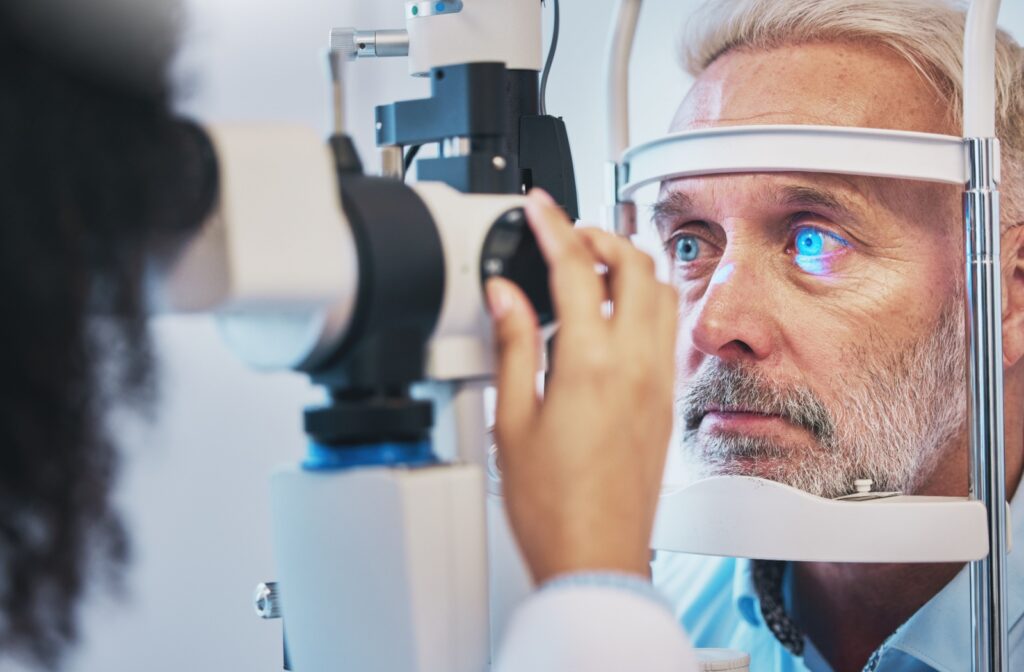Smoking is a habit often closely associated with cancer and organ damage. Still many people don’t realize it also significantly impacts your eyesight and can increase your risk of all kinds of eye conditions in life. It’s about more than maintaining your vision—it’s about protecting your eye health and preserving your quality of life. This begs the question—does eyesight improve after quitting smoking?
While quitting smoking won’t improve your vision, it can decrease the risk of potential problems like glaucoma and cataracts. Meanwhile, it also offers a host of other benefits that can improve your quality of life. Quitting tobacco usage is an excellent way to boost your overall health.
Consider speaking with our eye doctors in San Francisco at your next eye exam to learn more about how smoking may be affecting your eyes.
How Does Smoking Affect the Eyes?
When you smoke, you’re introducing a host of harmful chemicals into your body. It isn’t just tobacco and nicotine—a regular cigarette has more than 7,000 different chemicals when burned, many of which are known to cause cancer and other extremely dangerous effects.
Smoking is well-known for how it damages the sensitive parts of your body—like the eyes. Smoking can lead to:
- Inflammation
- Reduced blood flow
- Damaged tissue
- Constricted blood vessels
These effects can be both immediate and long-term. As the blood vessels constrict more often, your eyes receive less oxygen and essential nutrients, which can significantly increase the risk of all kinds of other eye problems. Tobacco usage isn’t harmless for the eyes—this habit can cause permanent vision loss in many cases, making it crucial to reduce this risk however you can.
Common Tobacco-Related Eye Conditions
Every time you smoke, you’re putting additional strain on the sensitive parts of your body, and the eyes are no exception. Smoking is closely linked to a higher risk of:
- Dry eye
- Cataracts
- Glaucoma
- Age-related macular degeneration
- Uveitis
Dry Eye
Dry eye is a condition characterized by dry, stinging sensations in the eyes. It develops when there’s an imbalance in your tear film, and is easily recognizable by constant inflammation and irritation. You can recognize dry eye by:
- Constant burning or stinging sensations
- Red eyes
- Excessively watery eyes
When you smoke, the chemicals in the tobacco can easily irritate the surface of the eyes, making the symptoms of dry eye much worse. Over time, it can become more difficult to maintain a healthy tear film to protect your eyes. Quitting smoking can reduce the risk of dry eyes, and may make the symptoms milder if you experience a flare-up.

Glaucoma
Glaucoma is a complex group of eye conditions recognized for the damage they cause to the optic nerve—the essential part of your visual system that transmits information to the brain. Usually, this damage is caused by abnormally high blood pressure in the eye. Glaucoma is a subtle condition that often develops slowly without any obvious symptoms.
People who smoke have a substantially higher risk of developing glaucoma than those who do not. Some research shows that when you smoke, you restrict blood flow to the eyes and optic nerve, depriving them of the nutrients needed to maintain a healthy ocular structure. This leads to a significantly higher risk of glaucoma.
Cataracts
Near the front of your eye, you have a natural lens, just like the lens on a camera. It’s responsible for helping focus light onto the retina. Usually, this lens is clear, allowing light to pass through with ease. However, over the years, the lens can begin to cloud. This condition, called cataracts, begins to obstruct light as it enters the eye. This leads to:
- Blurred or cloudy vision
- Increased difficulty seeing at night
- Sensitivity to light and glare
- Double vision in one eye
- Fading or yellowing of colors
Smoking increases the risk of cataracts. The chemicals in the smoke can cause oxidative stress and damage the proteins in the lenses, leading to cataracts. By avoiding smoking, you can reduce the risk of developing cataracts by protecting the integrity of your lens’ structure.
Age-Related Macular Degeneration
Age-related macular degeneration, or AMD, is a condition that affects the macula—the light-sensitive tissue in the retina responsible for your clear central vision. AMD is one of the leading causes of vision loss in older adults, and can be broken down into two categories:
- Dry AMD, which is much more common. This develops when the macula gets thinner with age and progresses slowly. While there is no permanent cure for AMD, it can be effectively managed to preserve your future vision.
- Wet AMD, which is much less common. This is considered an emergency and develops when abnormal blood vessels grow in the back of the eye. It is often a complication of dry AMD.
When you smoke, you’re damaging the sensitive tissues inside the eye. This can increase the risk of the macula thinning, leading to a higher risk of developing AMD. Quitting smoking and avoiding tobacco products can be one of the most effective ways to reduce the risk of AMD.
Get Your Vision Checked
Your eyesight is precious, and you should always try to protect it. While quitting smoking can make a significant difference, it’s important to remember to regularly schedule comprehensive eye exams with our team at Total Vision Financial District in San Francisco. We can monitor your eyes and address potential problems before they damage your vision.
Book your appointment with us today. We can help you take your next step towards clear vision and a healthier future.



